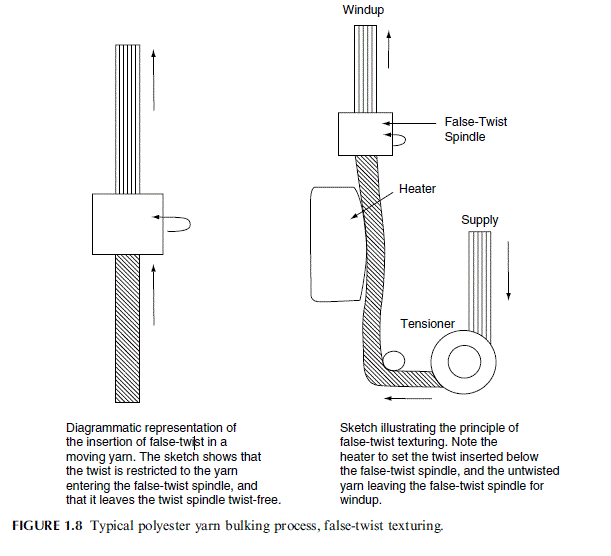Free Textile Article
All about textile & FiberFree Textile Article
All about textile & FiberPOLYESTER YARNS FOR SPECIFIC APPLICATIONS
For industrial use, high-tenacity yarns, such as the tire cord, have to be drawn under conditions
where low heat shrinkage, low extension, and high modulus products are produced. In fact, a tire
cord is a highly specialized product, and complete integrated continuous polymerization spinning
and drawing plants (cp-spin-draw) have been developed. The process is little discussed in the
open literature and the reader is directed to the patents of DuPont, Fiber Industries, and Allied
Chemical Corporation (none of these companies currently exist as fiber producers).
The demands of staple fiber are different from those of filament yarns. Staple fiber is a
continuous filament cut into short lengths in centimeters. Staple fibers are discontinuous and
are crimped and chopped to the desired staple fiber length to blend at the carding stage with
cotton (short staple), wool (long staple), or other natural fibers. The raw polyester fibers are
where low heat shrinkage, low extension, and high modulus products are produced. In fact, a tire
cord is a highly specialized product, and complete integrated continuous polymerization spinning
and drawing plants (cp-spin-draw) have been developed. The process is little discussed in the
open literature and the reader is directed to the patents of DuPont, Fiber Industries, and Allied
Chemical Corporation (none of these companies currently exist as fiber producers).
The demands of staple fiber are different from those of filament yarns. Staple fiber is a
continuous filament cut into short lengths in centimeters. Staple fibers are discontinuous and
are crimped and chopped to the desired staple fiber length to blend at the carding stage with
cotton (short staple), wool (long staple), or other natural fibers. The raw polyester fibers are

melt-spun through many hundreds of holes in a staple spinneret, and hauled off via a godet,
but not wound up in the conventional way. Instead, they are deposited via an air ejector
loosely into a large drum or ‘‘yarn can.’’ When the yarn can is full, fiber bundles from many
cans are combined into a thick bundle of fibers called a ‘‘tow.’’ These tows may have a yarn
count of several million decitex. The thick bundle of fibers is then drawn on a massively
constructed drawframe (because the mechanical forces involved are heavy) using multiple sets
of draw rolls and feed rolls. The yarn is heat-set in a steam-heated hot box, because this
method gives the best thermal transfer to the individual fibers in the tow. The drawn tow then
passes to a crimper, often of the stuffer-box type. The tow is overfed into a heated wedgeshaped
box with a sprung lid, where it is compressed to form a concertina-type crimp. The
bulked tow is finally cut to the desired staple length using a continuous staple cutter. The
loose cut fiber is then transferred by an air handler to a bin and compressed into bales. A
schematic diagram of a staple line is shown in Figure 1.9.
but not wound up in the conventional way. Instead, they are deposited via an air ejector
loosely into a large drum or ‘‘yarn can.’’ When the yarn can is full, fiber bundles from many
cans are combined into a thick bundle of fibers called a ‘‘tow.’’ These tows may have a yarn
count of several million decitex. The thick bundle of fibers is then drawn on a massively
constructed drawframe (because the mechanical forces involved are heavy) using multiple sets
of draw rolls and feed rolls. The yarn is heat-set in a steam-heated hot box, because this
method gives the best thermal transfer to the individual fibers in the tow. The drawn tow then
passes to a crimper, often of the stuffer-box type. The tow is overfed into a heated wedgeshaped
box with a sprung lid, where it is compressed to form a concertina-type crimp. The
bulked tow is finally cut to the desired staple length using a continuous staple cutter. The
loose cut fiber is then transferred by an air handler to a bin and compressed into bales. A
schematic diagram of a staple line is shown in Figure 1.9.
برای نمایش آواتار خود در این وبلاگ در سایت Gravatar.com ثبت نام کنید. (راهنما)






















































ایمیل شما بعد از ثبت نمایش داده نخواهد شد